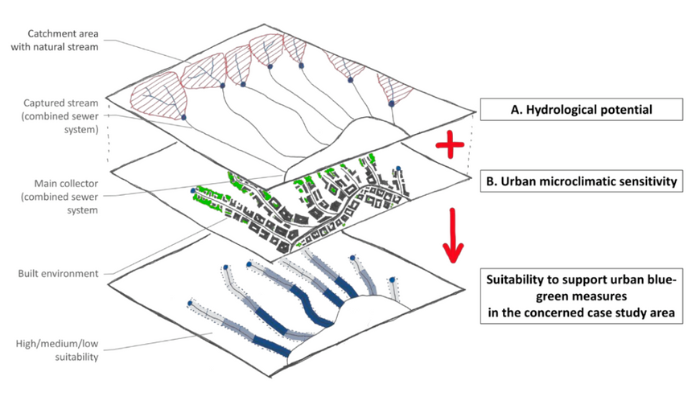
With advancing climate change, mitigation measures are necessary to fight urban heat islands. Reactivating urban streams as blue-green infrastructures can contribute to this mitigation, and serve as an invaluable water resource.
Urban streams – banned to the underground
In urban areas, hydrological conditions have been modified, impacted or completely changed for centuries.
Rivers and streams once acted as transportation ways and settlements developed along their courses. Industry used the water for energy production, cooling water and wastewater disposal.
However, industrial activity and increasing population densities led to water quality issues. Diseases spread along the waterways and floods threatened settlements.
In Vienna, starting in the 16th century, urban running waters were increasingly modified, channelized, banned into the underground or inundated into the sewage system.
Nowadays, their natural catchment areas are reduced or non-existent. This, in combination with soil sealing, has led to heavily modified hydrological conditions.

Climate change and the resurgence of urban streams
Climate change has brought rising attention to urban running waters in various ways.
According to the IPCC, changed weather patterns affect urban spaces through heavy precipitation events as well as heat and drought periods. The former requires increasing attention to capacities in the urban drainage system, stormwater management and flash flood prevention. The latter necessitates urban heat islands (UHI) mitigation combined with limitations in fresh water usage.
Urban streams, as blue-green infrastructures, can be seen as a multifunctional tool – a nature-based solution to address all the above-mentioned aspects.
Research shows that urban running waters can support rainwater management via the creation of new retention volumes. Furthermore, several studies highlight the role of riparian vegetation, which interacts with running waters and is a crucial element of the hydromorphological processes.
Additional shading effects from the vegetation can be used for the mitigation of urban heat islands (UHI) and to improve recreational areas. Through the combination of blue and green elements, microclimatic cooling effects become available.
In addition, the water from the streams can be used for irrigation purposes and drinking water resources can be conserved.
Reactivation, decoupling, daylighting
Possibilities to reactivate urban streams are diverse, dependent on local conditions and the degree of modification of the former running water. It also depends on whether a stream is simply routed underground (“piped”), or fed into the sewage system.
For piped streams, daylighting is relatively simple from a technical perspective – it means opening up the stream’s underground confinements. Space availability and flood control are the restricting factors.
For streams flowing within the sewage system, a more challenging approach called decoupling is used. Stream water has to be carefully separated from wastewater. Compared to piped streams, the prevailing catchment area is often strongly reduced and available amount of water is limited.
At the end of the day, there are many potential solutions, as well as obstacles, opportunities and risks when it comes to reactivating urban streams. To analyse these, an interdisciplinary research project was launched in Vienna – ProBACH.
The ProBACH project: assessing stream’s reactivation suitability
ProBACH (“Bach” is German for stream) explores the potential of urban water reactivation in terms of mitigating climate change effects along the former river courses. It investigates the climatic effectiveness of streams and rainwater and promotes the creation of high-quality, socially beneficial recreation areas.

Methodical approach for the suitability pre-assessment for decoupling in-sewer captured streams to support urban blue-green climate adaptation measures within ProBACH. Picture: Prenner et al. (2022)
As a first step, the project has analysed the hydrological potential and microclimatic sensitivity of 16 stream catchments in the North-Western part of Vienna. These catchments cover an area of 95 km² and are home to 500,000 inhabitants.
First results show that one third of investigated flow paths show a high or medium suitability for supporting blue-green climate change mitigation measures. With respect to heat island mitigation, water use efficiency, and recreational quality, it can be concluded that decoupling or daylighting captured streams could contribute to a more sustainable and nature-based urban water management.
Next, ProBACH will try to quantify the climate effectiveness of reactivated urban streams and find ways to maximize benefits of combined blue-green infrastructure elements given the limited available space.
The future of urban streams is their reactivation
The key to effective urban climate mitigation lies in meeting additional water demand. Reactivating urban running waters can help meet this resource demand.
Installing blue-green spaces along former water courses in an urban context impacts local conditions beyond microclimatic effects. These infrastructures can serve as recreational areas, function as ecological stepping stones, and relieve wastewater systems.
Nevertheless, the effectiveness of planned measures must be carefully modelled and tested, and the available water resources assessed. From a cost-benefit perspective, a quantification of ecosystem services is indispensable.
Edited by C. Orieschnig
